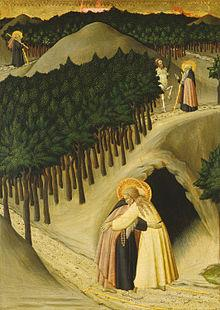St Anthony of Egypt

Abbot. Anthony was born in 251 in Upper Egypt. When he was 20, his parents died, leaving him a large estate. After much prayer Anthony decided to sell his possessions and give the money to the poor. His younger sister joined a community of religious women while Anthony went to live in a deserted fort in complete solitude from 286 to 306. During this time he is said to have withstood many temptations. At the end of this time he gathered a group of disciples around him. He visited Alexandria to encourage the Christians there who were being persecuted by Maximinus. In 355 he went to Alexandria to refute the Arians. His surviving letters include one to the Emperor Constantine and several to different monasteries. Anthony was said to be a miracle worker and converted many people to Christianity.
Jerome's account of Paul the first hermit, describes a meeting with Anthony in the desert shortly before Paul's death, at which a raven dropped a loaf of bread. Afterwards lions dug a grave for Paul, and Anthony buried him in a cloak given by Athanasius.
Anthony is said to have died at the age of 105 and asked to be buried in a place known to none. But in 561 his remains were moved to Alexandria. Translations were later claimed by Constantinople and La Motte, where the Order of Hospitallers of St Anthony was formed. This became a pilgrimage centre for those who suffered from ergotism (St Anthony's Fire).
The hospitallers wore black robes and rang bells to attract alms. The bells were later hung around the necks of animals to prevent disease. By special privilege, the order's pigs were allowed to roam the streets freely wearing bells. The emblem of pigs and bells later became part of St Anthony's iconography.
The earliest known representation of St Anthony is the Ruthwell Cross, made in 750 and eight Irish crosses made before 1100. His Illustrated Life survives in Valetta in Malta and Florence. The temptations of Anthony have been portrayed by many artists including Bosch and Grunwald. He is depicted in stained glass in Chartres.
St Anthony was immensely popular in the Middle Ages. Regarded as a patriarch of monks and a healer of both people and animals, he left his trace on the English language through the word 'tantony' which means the smallest of a peal of bells and the smallest of a litter of pigs. His Legend in English verses is depicted on the stalls at Carlise Cathedral.












